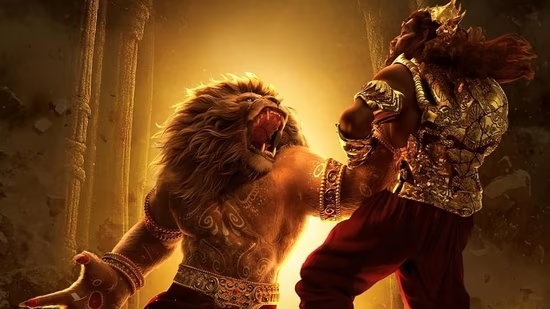
When myth, grit, and belief met in a cramped studio, Indian animation changed forever.
No glittering studio. No corporate backers. A rented Bengaluru room, a few passionate artists, and a tale that did not want to remain on paper. Such was the birth of *Mahavatar Narsimha* — an animated epic made from India’s ancient mythologies, created after five years of struggle, two pandemic lockdowns, and even a home loan. When it finally hit cinemas, it didn’t only receive applause — it broke records, going across **₹200 crore globally** and doing away with Disney and Marvel at the box office. This was not only a film outing; this was the day Indian animation discovered its roar.
The Modest Rented Room Where a Five-Year Dream Took Shape
Five years ago, Ashwin Kumar sat in a small rented flat in Bengaluru, sketching scenes that would one day challenge Hollywood’s animation giants.
There were no plush offices, no corporate tie-ups — just a team of under 20 artists, huddled between drawing tablets and lunch boxes, dreaming of retelling India’s mythology in a way the world had never seen.
“Our home is leased, our savings gone, but this film was worth every rupee,” Ashwin recalls. “This wasn’t a cartoon. This was cinema.”
The Endless Rejections That Only Strengthened the Team’s Resolve
Studio after studio turned them away. Some called the idea “too niche,” others dismissed it as “animation for kids.”
But Ashwin was determined to make a universal, mature mythological epic — not a watered-down children’s version. He refused to compromise the core of the story: a battle between good and evil that transcends age and faith.
Why the Story of Narsimha and Varaha Is So Powerful for Modern Times
Half-lion and half-human Narsimha is the fourth avatar of Vishnu, a character in Hindu mythology, who rescues the devotee Prahlad and slays the tyrant Hiranyakashipu.
Ashwin combined this with the Varaha story, creating a multi-faceted story of hope overcoming impossibility — a message as relevant today as it has ever been in ancient scripture.
How the Filmmakers Turned Technical Challenges Into Artistic Triumphs
- Style of Production: Animated at 24 frames per second to employ cinematic smoothness
- Art Style: Hand-drawn characters with CGI-rendered backgrounds for depth
- Total Workload: Over 2.5 lakh individual frames painstakingly created
- Lockdown Challenges: Remote work on slow home internet, often sending massive files overnight
- Color Language: Gold-crimson tones for divinity, blue-grey palettes for darkness and evil
The Ambitious Plan to Build a Seven-Film ‘Mahavatar Cinematic Universe’
Ashwin sees Mahavatar Narsimha as just the beginning. It’s the first chapter in a seven-film series that will cover all ten avatars of Vishnu over the next decade — India’s first fully planned mythological animated universe. Each film will interconnect, creating a narrative tapestry inspired by ancient texts but executed with world-class animation technology.
The Box Office Journey That Proved Indian Animation Can Conquer the World
- ₹100 crore in just 12 days
- ₹200+ crore worldwide by week three
- Outperformed Disney and Marvel films in India’s 2025 box office rankings
- Overseas screenings sold out in the US, UK, and Australia.
What the Creators Themselves Say About the Film’s Deeper Purpose
For director **Ashwin Kumar**, *Mahavatar Narsimha* is more than an animated spectacle — it’s a meditation on belief itself. “Whether you believe in God, in energy, or the universe — this film is about surrendering to that faith,” he explains. “It’s not about conversion; it’s about conviction.” His vision was never to push a single religious perspective, but to craft a story that could resonate with anyone who holds on to something greater than themselves. Producer **Chaluve Gowda** shares the same conviction in the film’s deeper mission and the people behind it. “Even Disney has all Indian animators,” he points out. “The talent was always here — it just needed belief.”
The Emotional Reactions That Show the Film’s Universal Appeal
- “They didn’t just watch it… they felt it.” – Parent in Mumbai.
- “This strengthened my faith. The message goes beyond religion.” – Viewer in Hyderabad.
- Schools booking weekday shows, calling it “an animated history lesson with a soul.”
- Social media fan art flooding X (Twitter) and Instagram
The Four Key Reasons This Film Is a Turning Point for Indian Animation
- Budget vs. Returns: Made for a fraction of a Disney budget, yet matched global box office appeal
- Breaking the Kid-Only Myth: Proved animation can engage adults in India.
- Cultural Export: Resonated with international audiences without losing the Indian essence
- Industry Impact: Inspired other studios to invest in mythological animation
A Roar From the Screen That Mirrors the Ancient Legend
In the myth, Narsimha emerges from a pillar to destroy tyranny when all hope seems lost.
In reality, Mahavatar Narsimha emerged from a cramped workspace to shatter stereotypes about Indian animation.
“Narsimha protects faith. We protected our dream,” Ashwin says with a smile.
From rented rooms to ₹200 crore and counting, this isn’t just a film’s success — it’s a historic moment for Indian storytelling.
FOR MORE BLOGS –beyondthepunchlines.com

 Add to favorites
Add to favorites







